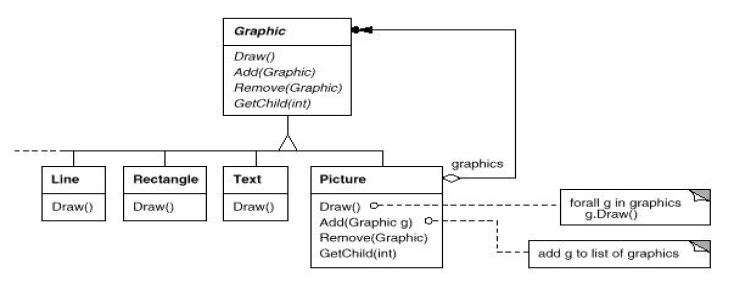CS3340: Intro OOP and Design |
||||||
|
Composite Pattern
The composite pattern describes that a group of objects are to be treated in the same way as a single instance of an object. The intent of a composite is to "compose" objects into tree structures to represent part-whole hierarchies. Implementing the composite pattern lets clients treat individual objects and compositions uniformly.

To be able to treat individual objects and compositions in the same manner. You can manipulate a single instance of an object the same as you would a group of them.
a composite = is an object designed as a composition of one-or-more similar objects, all exhibiting similar functionality. This is known as a "has-a" relationship between objects.
Motivation
When you have tree-structured data, programmers often have to discriminate between a leaf-node and a branch. This makes code more complex, and therefore, error prone. The solution is an interface that allows treating complex and primitive objects uniformly.
Solution --- How it works
Split into Component, Composition (and optional) Leaf classes. Each class has the same operation
|
|

Example in Java
Has a graphic class, which can be either an ellipse or a composition of several graphics. Every graphic can be printed (shared operation).
Graphic = ellipse | GraphicList GraphicList = empty | Graphic GraphicList
It could be extended to implement several other shapes (rectangle, etc.) and methods (translate, etc.).
import java.util.List;
import java.util.ArrayList;
/** "Component" */
interface Graphic {
//Prints the graphic.
public void print(); }
/** "Composite" */
class CompositeGraphic implements Graphic {
//Collection of child graphics.
private List<Graphic> childGraphics = new ArrayList<Graphic>();
//Prints the graphic.
public void print() {
for (Graphic graphic : childGraphics) {
graphic.print(); }
}
//Adds the graphic to the composition.
public void add(Graphic graphic) {
childGraphics.add(graphic);
}
//Removes the graphic from the composition.
public void remove(Graphic graphic) {
childGraphics.remove(graphic);
}
}
/** "Leaf" */
class Ellipse implements Graphic {
//Prints the graphic.
public void print() {
System.out.println("Ellipse");
}
}
/** Client */
public class Program {
public static void main(String[] args) {
//Initialize four ellipses
Ellipse ellipse1 = new Ellipse();
Ellipse ellipse2 = new Ellipse();
Ellipse ellipse3 = new Ellipse();
Ellipse ellipse4 = new Ellipse();
//Initialize three composite graphics
CompositeGraphic graphic = new CompositeGraphic();
CompositeGraphic graphic1 = new CompositeGraphic();
CompositeGraphic graphic2 = new CompositeGraphic();
//Composes the graphics
graphic1.add(ellipse1);
graphic1.add(ellipse2);
graphic1.add(ellipse3);
graphic2.add(ellipse4);
graphic.add(graphic1);
graphic.add(graphic2);
//Prints the complete graphic (four times the string "Ellipse").
graphic.print();
}
}
